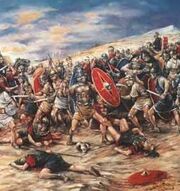| The Etruscan Rebellion |
|||||||
|---|---|---|---|---|---|---|---|
| Part of Vae victis! | |||||||
 The Dardanian guard fighting rebels |
|||||||
|
|||||||
| Belligerents | |||||||
Etruscan government
| Etruscan rebels
|
||||||
| Commanders and leaders | |||||||
| Gaius Dardania | Many leaders | ||||||
| Strength | |||||||
| 10,000 | 23,000 | ||||||
| Casualties and losses | |||||||
| 1,700 | 9,000 | ||||||
The Etruscan rebellion was a devastating war that gripped Etrusca for three years. It was started over perceived oppression by the appointed senate members, and went on to inflame the rest of the country. Ultimately, the rebellion would backfire, and the etruscan government would become even more autocratic then it was, and any hope of rebellion was squashed for hundreds of years to come. This war would define the politics of Etrusca, and is arguably the reason the nation eventually folded into Dardanian Etrusca.
Background
Because the Etruscan senate was largely dominated by the appointed members rather than the elected ones, people in Etrusca felt they were being oppressed. This lead to much negative sentiment among the citizens of Etrusca, particularly the lower class. The riots that broke out over the issue didn't serve to help the tension either, as the Dardanian guard became increasingly brutal in fighting them. The situation got worse and worse, and finally in the spring of 234, it broke out into full scale rebellion.
Fighting
The first rebellions to break out were confined to former Umbrian lands, and very little violence was involved. However, as the government refused to put up a resistance, the movement spread across Etrusca becoming increasingly violent. Soon, several cities were under the effective control of rebels, and the army of the republic, a loose coalition of various rebel groups. Realizing they had to respond, the Etruscan government sent the Dardanian Guard into action. this deadly force quickly crushed many major riots, and killed armed rebels. They were effective to the point that they almost managed to bring down the army of the republic, and forced them back in the process.
After the Dardanian Guard forced the rebels back, Gaius Dardania moved in with his army to destroy the army of the republic. His first attack was a failure, and he barley manged to escape with his life. However, he rallied his troops, and launched a second attack on the unsuspecting army. This attack turned the war in his favor, and sent the Army of the Republic reeling. As his enemy stumbled back, Gaius gripped his advantaged and hammered the army of the republic apart. after several years of intense fighting, Gaius was finally able to declare victory over the Rebels, and the restoration of the Etruscan senate.
Aftermath
Following the war, the Etruscan senate shifted to a council of 60 members, all who were appointed by the king. This lead to almost complete Dardanian domination f the senate, and the rest of Etruscan politics. The expansionist policies of the new Senate lead to increased tensions with Safineim, and two more wars with the nation. After the war, very few rebellions existed in Etrusca, and the few that did were quickly crushed. Ultimately the war lead to the fall of Etrusca in 13 AD.
| |||||||||||||||||||||||||||

